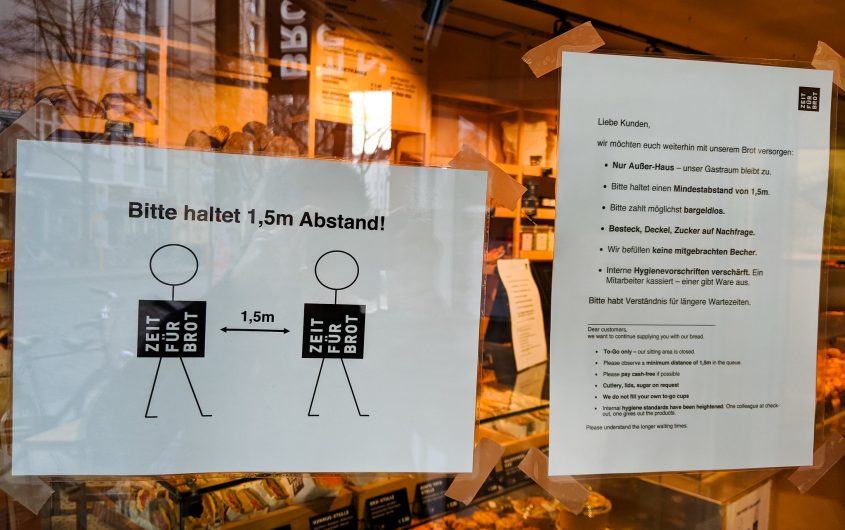
Mitch Altman via Flickr
Tackling the Coronavirus in Germany

Christine Arentz
Christine Arentz is a Professor for (Health) Economics at the Institute for Insurance Studies (ivwKöln) at TH Köln – University of Applied Sciences (Cologne, Germany).
Her professional experience includes four years of working as a Senior Economist and Project Manager at the Scientific Institute of the Private Health Insurance (WIP) in Cologne, Germany, where she managed research projects in International Health Care System Comparisons, (German) Health Policy and Long-term Care.
She holds a PhD in Economics and completed her thesis at the Institute of Economic Policy at the University of Cologne (Germany), where she worked as a researcher, lecturer, and policy advisor. In the earlier stages of her career, she worked as a credit analyst in international real estate, as well as a research assistant both at the United Nations Economic Commission for Europe (UNECE) and the German Central Bank.

Ines Läufer
Ines Läufer works as a systemic organizational consultant, specializing in the public sector. Starting in October 2021, she will work as in-house consultant for the association of municipalities in North Rhine-Westphalia.
She holds a PhD in economics and completed her dissertation at the Institute for Economic Policy at the University of Cologne, where she worked as a researcher, lecturer and policy advisor.
In 2013, she spent three months as a fellow at AICGS, where she conducted research on "Accessibility and Efficiency of Private Health Insurance in the United States and Germany."
After completing her PhD, she worked as an economist at the German Federal Ministry of Health for nearly three years before turning her attention to organizational change and workplace cultures in the public sector as a key issue of good policy.
First and Second Wave Compared
Germany has been internationally praised for its management of the first pandemic wave of Covid-19. This may make the current development in Germany with much higher numbers of infected persons than in the first wave, regionally overburdened hospitals, and rising deaths all the more surprising to observers abroad. The second wave has made clear how much even a well-equipped healthcare system depends on targeted political action and the support of the population.
Early decisive containment measures and a disciplined population were success factors in the first wave. During the pandemic, the health system also demonstrated a high degree of flexibility. Inpatient capacities, which were already comparatively high before the pandemic, were further increased and staff were relieved by postponing non-urgent treatments. These additional capacities did not have to be used in the first wave because infection figures were quickly brought under control and fell sharply during the summer. In addition, a high number of patients could be treated in the outpatient sector, since they were comparatively young and healthy. The smaller number of severe cases were treated in specialized clinics, which were prepared in terms of personnel and equipment. Germany also had a head start in coping with the pandemic due to the early development of diagnostic tests for Covid-19 and the laboratory capacity available in all regions of Germany.
The management of the second wave is much harder. Intensive care capacities, albeit not exhausted throughout Germany, reached their limits in some regions, and infections and deaths are high compared to the first wave.
The reasons for this are certainly complex and a final assessment will only be possible in a few months. Some factors can however be identified.
Preparation for a possible second wave was neglected throughout the summer, and the government has neglected to create or communicate a long-term national strategy.
First, preparation for a possible second wave was neglected throughout the summer. After successfully managing the first wave, there seemed to be too much complacency, and parts of the public even questioned the necessity of the tougher measures in spring (prevention paradox). Local health authorities responsible for contact tracing were not digitally upgraded and staffed as quickly as promised and were consequentially overburdened as infection rates rose. Protecting nursing homes better and equipping vulnerable groups with FFP2 masks also did not occur until infection rates reached peak levels, although especially these groups often need hospital treatment when infected.
Second, the government has neglected to create or communicate a long-term national strategy. To date, there is no uniform nationwide strategy that informs the population which restrictions come into force in which areas of society if certain thresholds are exceeded. Instead, lockdowns are introduced ad-hoc and prolonged from date to date, thereby potentially increasing frustration in the population.
When case numbers rose in the fall and contact tracing by the regional health authorities increasingly reached its limits, there was no political agreement on how to respond. The federal states, which were unevenly affected in terms of infections, were unable to agree on uniform rules. Federalism can be advantageous in combating the pandemic because developments can be reacted to more quickly at the regional level. But different rules and opinions of the individual federal states can be confusing and disconcerting for at least parts of the population.
A consistent, evidence-based strategy in combating the pandemic that is comprehensible to the population, thereby increasing compliance is essential to rapidly reduce risk contacts.
The main problem is still the lack of meaningful and robust data to inform evidence-based decisions. Consequently, it remains unclear how societal sectors contribute to spreading the virus. Furthermore, the Corona warning app was and is not used to identify sources of infection for data protection reasons. The lack of data threatens to undermine the acceptability of the measures, as it is unclear whether policymakers are hitting the right areas. However, because of the sacrifices and existential risks associated with the measures for many, it is precisely the doubt about the effectiveness of these measures that is problematic, as it can reduce discipline in following effective measures.[1]
As the “light” lockdown imposed nationwide in November (closure of restaurants, cultural venues, and leisure areas while stores and schools remained open) did not produce the desired containment of infection numbers, Germany returned to tightened measures with closed schools and closed shops in December. However, employers were only forced to offer home office wherever possible late in January, when lockdown was extended again until mid-February. These inconsistencies in policies and the lack of perspectives threaten to increase pandemic fatigue in the population.[2]
A consistent, evidence-based strategy in combating the pandemic that is comprehensible to the population, thereby increasing compliance is essential to rapidly reduce risk contacts. In contrast to the first wave, political action and citizen behavior have been less prompt and stringent, and consequently, the inpatient sector came under stress, at least regionally.
The comparatively slow pace of vaccination in Germany is also a source of debate. While a German-American collaboration has been able to launch the first vaccine against Covid-19, distribution of the vaccine in Germany has been bumpy so far. European countries such as Italy and Spain, which initially lagged behind Germany, have currently administered more doses,[3] even though they face the same current supply shortages.[4]
Therefore, effective protection measures for the vulnerable, better risk communication, and motivation of the population are even more important until a major part of the population is protected by vaccines.
[1] The COSMO survey shows that already today, a relevant part of the population does not, or not always, comply with the rules on pandemic control. https://dfncloud.uni-erfurt.de/s/LTAPWD8DmXToBee#pdfviewer (accessed January 12th, 2021).
[2] A recent study of the Rheingold Institute, Germany stated that besides those inconsistencies, especially the lack of success in reducing infection numbers and a dwindling fear of Covid-19 contribute to less behavioral discipline than in the first wave. See https://www.rheingold-marktforschung.de/schwindende-angst-und-fehlende-erfolgserlebnisse-untergraben-corona-regeln/ (accessed January 27th)
[3] See https://ourworldindata.org/covid-vaccinations, accessed on January 21, 21, data January 19.
[4] The EU had decided to place joint orders for vaccines to guarantee every member state access. In the summer, the EU Commission had placed these orders with various vaccine manufacturers in order to diversify. However, this has initially resulted in comparatively too little vaccine being ordered from the successful vaccine manufacturers, so that there are now temporary shortages.









